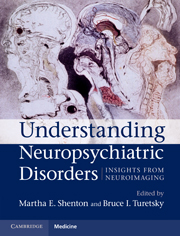Book contents
- Frontmatter
- Contents
- List of contributors
- Preface
- Section I Schizophrenia
- 1 Structural imaging of schizophrenia
- 2 Functional imaging of schizophrenia
- 3 Spectroscopic imaging of schizophrenia
- 4 Neuroreceptor imaging of schizophrenia
- 5 Neuroimaging of schizophrenia: commentary
- Section II Mood Disorders
- Section III Anxiety Disorders
- Section IV Cognitive Disorders
- Section V Substance Abuse
- Section VI Eating Disorders
- Section VII Developmental Disorders
- Index
- References
3 - Spectroscopic imaging of schizophrenia
from Section I - Schizophrenia
Published online by Cambridge University Press: 10 January 2011
- Frontmatter
- Contents
- List of contributors
- Preface
- Section I Schizophrenia
- 1 Structural imaging of schizophrenia
- 2 Functional imaging of schizophrenia
- 3 Spectroscopic imaging of schizophrenia
- 4 Neuroreceptor imaging of schizophrenia
- 5 Neuroimaging of schizophrenia: commentary
- Section II Mood Disorders
- Section III Anxiety Disorders
- Section IV Cognitive Disorders
- Section V Substance Abuse
- Section VI Eating Disorders
- Section VII Developmental Disorders
- Index
- References
Summary
With all technological advances there is the initial infatuation followed by more thoughtful reassessment. In vivo, non-invasive magnetic resonance spectroscopy (MRS) has progressed along this trajectory over the past 20–30 years. While much of the initial excitement revolved around technological advances, case reports, and small clinical studies, now is a good time to engage in a thoughtful reassessment of the potential new insights and pitfalls provided by this technology. This review will attempt this assessment in the context of MRS findings in schizophrenia research.
The first part of the review will address fundamental technological considerations followed by a discussion of what molecular and metabolic information can be obtained from 31P and 1H MRS. This will be followed by a selective review of the literature to date on 31P and 1H MRS studies in schizophrenia.
High field methodological issues
The development of in-vivo MR spectrometers with higher magnetic fields potentially increases sensitivity; however, methodological issues limit the anticipated improvement in both sensitivity (signal to noise ratio) and spectral resolution (Fleysher et al., 2009). These methodological issues are discussed below.
Signal–noise ratio (SNR) following a 90 degree pulse along the rotating frame y-axis
The SNR improves with higher magnetic field (B 0). Under ideal conditions, one can calculate the theoretical SNR.
- Type
- Chapter
- Information
- Understanding Neuropsychiatric DisordersInsights from Neuroimaging, pp. 48 - 77Publisher: Cambridge University PressPrint publication year: 2010

